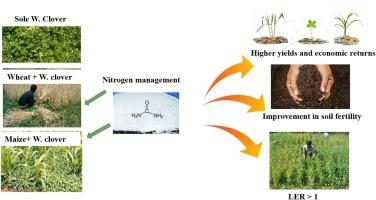European Journal of Agronomy ( IF 5.2 ) Pub Date : 2021-07-15 , DOI: 10.1016/j.eja.2021.126354 Inder Dev 1 , Asha Ram 1 , Sudesh Radotra 2 , B.K. Misri 2 , Sindhu Sareen 3 , Pardeep Kumar 4 , Deepak Singh 5 , Sushil Kumar 1 , Naresh Kumar 1 , Ramesh Singh 1

|
We studied the integration of white clover (Trifolium repens) with nitrogen management practices in wheat (Triticum aestivum L.) - maize (Zea mays L.) cropping sequence to find optimum level of N and to enhance forage production. This experiment was laid out in Randomized Block Design with three replications comprising of 12 treatments viz., (T1) wheat-maize; (T2) white clover + wheat -maize (0 N); (T3) white clover (sole); and (T4 to T12) 50, 75 and 100 % of recommended N to wheat, maize or both. Application of 100 % N to white clover + wheat - maize (bi-cropping) recorded the highest crude protein in white clover. Wheat equivalent yield (WEY) was computed by multiplying the white clover and maize yields with their respective per unit price to compare the system productivity. The system productivity was found 2.67 (56.92 %) and 5.93 t/ha (315.42 %) higher in 100 % N application to bi-cropping over wheat-maize (0 N) and sole white clover, respectively. Highest net returns (US $ 188.5 and 224.0/ha at farmers’ field and research farm, respectively) were also recorded in the same bi-cropping treatment. Bi-cropping along with N application resulted in higher Land equivalent ratio (LER) (18.01–57.65%) over sole cropping. The treatment and treatment x environment (TTE) bi-plot also explained 99.84, 98.70 and 99.63 % of treatment and treatment × environment variation for WEY, Benefit: Cost Ratio (BCR) and LER, respectively. Soil fertility improved significantly in sole white clover and bi-cropping treatments with N application. However, when upto 75 % N of recommended dose of fertilizers (RDF) was applied to bi-cropping system resulted in higher WEY, BCR and LER, which were at par with 100 % N. Thus, cereal-clover bi-cropping system along with 75 % N of RDF can be recommended for sustainable forage and food production; and better soil health in temperate, sub-temperate climatic regions of the world.
中文翻译:

用于喜马拉雅地区可持续牧草生产的谷物三叶草双作
我们研究了白三叶草(Trifolium repens)与小麦(Triticum aestivum L. ) - 玉米(Zea mays L. )种植顺序中氮管理实践的整合,以找到最佳氮水平并提高草料产量。该实验采用随机区组设计,包括 12 个处理,即 (T 1 ) 小麦-玉米;(T 2 ) 白三叶草+小麦-玉米(0 N);(T 3 ) 白三叶草(鞋底);和 (T 4到 T 12) 50%、75% 和 100% 推荐给小麦、玉米或两者的氮。将 100% N 施用于白三叶草 + 小麦 - 玉米(双作)记录了白三叶草中最高的粗蛋白。小麦当量产量 (WEY) 是通过将白三叶草和玉米产量与其各自的单价相乘来计算的,以比较系统生产力。发现在 100 % 施氮到小麦-玉米 (0 N) 和唯一白三叶草的双作中,系统生产力分别提高了 2.67 (56.92 %) 和 5.93 t/ha (315.42 %)。最高的净收益(农民田间和研究农场分别为 188.5 美元和 224.0 美元/公顷)也记录在相同的双作处理中。与单作相比,双作和施氮导致更高的土地当量比 (LER) (18.01–57.65%)。处理和处理 x 环境 (TTE) 双图还分别解释了 WEY、收益:成本比 (BCR) 和 LER 的 99.84、98.70 和 99.63% 的处理和处理 x 环境变化。单作白三叶草和双作施氮处理显着提高了土壤肥力。然而,当将高达 75 % N 推荐剂量的肥料 (RDF) 应用于双作系统时会导致更高的 WEY、BCR 和 LER,与 100 % N 相当。因此,谷物 - 三叶草双作系统沿75 % N 的 RDF 可推荐用于可持续的草料和食品生产;以及世界温带、亚温带气候地区更好的土壤健康状况。单作白三叶草和双作施氮处理显着提高了土壤肥力。然而,当将高达 75 % N 推荐剂量的肥料 (RDF) 应用于双作系统时会导致更高的 WEY、BCR 和 LER,与 100 % N 相当。因此,谷物 - 三叶草双作系统沿75 % N 的 RDF 可推荐用于可持续的草料和食品生产;以及世界温带、亚温带气候地区更好的土壤健康状况。单作白三叶草和双作施氮处理显着提高了土壤肥力。然而,当将高达 75 % N 推荐剂量的肥料 (RDF) 应用于双作系统时会导致更高的 WEY、BCR 和 LER,与 100 % N 相当。因此,谷物 - 三叶草双作系统沿75 % N 的 RDF 可推荐用于可持续的草料和食品生产;以及世界温带、亚温带气候地区更好的土壤健康状况。


























 京公网安备 11010802027423号
京公网安备 11010802027423号